Warplanes of Germany: captured Allied aircraft flown by the Luftwaffe
Deutsche Kampfflugzeuge 1939-1945, Gefangene alliierte Flugzeuge im Luftwaffendienst
German Warplanes 1939-1945,
Captured Allied Aircraft in Luftwaffe service

(Luftwaffe Photo)
Airspeed AS.6 Envoy, captured British transport aircraft.

(Luftwaffe Photo)
Avia B-534K biplane fighter captured in Czechoslovakia.
Avia B-71 bomber captured in Czechoslovakia.

(Luftwaffe Photo)
Bristol Blenheim Mk. IV, captured British light bomber.
Rogožarski IK-3 fighter captured in the Kingdom of Yugoslavia.

(Luftwaffe Photo)
Bloch MB.152, captured French fighter.
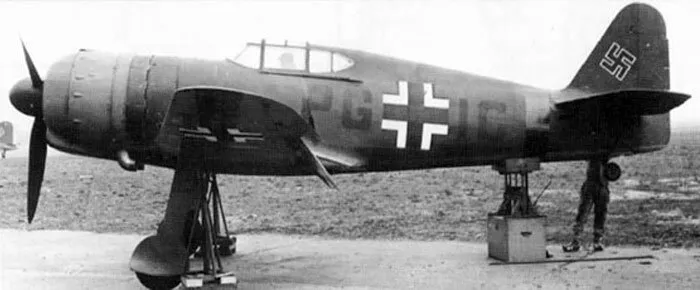
(Luftwaffe Photo)
Bloch M.B.175 bomber , PG+IC, captured in France.
This is the only Marcel Bloch MB 157 (conversion of a MB 152 meant to have a 1,580hp Gnome-Rhône 14R-4 engine) ever built. It was taken by the Luftwaffe for evaluation. After a series of very promising test flights, the aircraft was flown to Paris-Orly, where the Germans removed the engine (it was a slightly less powerful one) and brought it to the Gnome-Rhône factory at Bois-Colombes. The aircraft remained in an incomplete state in Orly, until it was destroyed in an Allied air raid. During the research phase under German control, it wore the German registration code PG+IC. (Vintage Wings of Canada)

(Luftwaffe Photo)
Boeing B-17 Flying Fortress captured USAAF bomber.
Caproni Ca.313 Italian bomber.
Caudron C.445 transport captured in France.
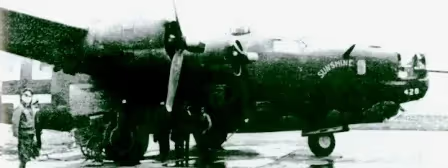
(Luftwaffe Photo)
Consolidated B-24 Liberator captured USAAF bomber.

(Luftwaffe Photo)
Dewoitine D.520 fighter captured in France.


(Regia Aeronautica Photos)
Fairey Swordfish captured British torpedo bomber. Swordfish K8403 (E4M with the "Savoy's Cross" on the tail) of 813 squadron from HMS Eagle shot down in raid on Maritza airfield, Rhodes, 4 September 1940. The aircraft force-landed on Scarpanto island. Crew all taken POW. The captured Swordfish was at Guidonia in December 1940. It was kept serviceable till the middle of 1941 using spare parts coming from captured Swordfish K8422 ("4H").
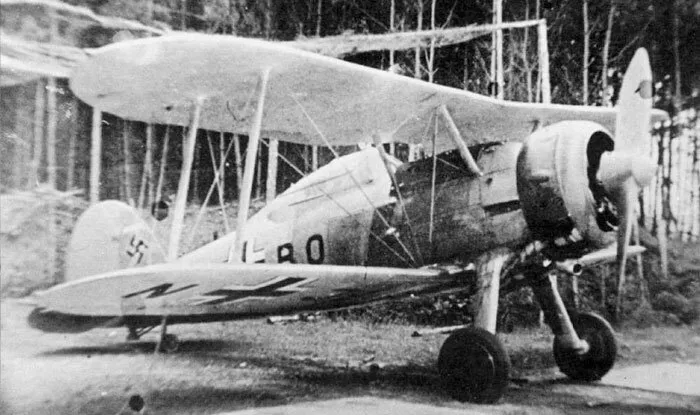
(Luftwaffe Photo)
Gloster Gladiator Mk. I (Wk Nr. 45829), British/Latvian biplane fighter.
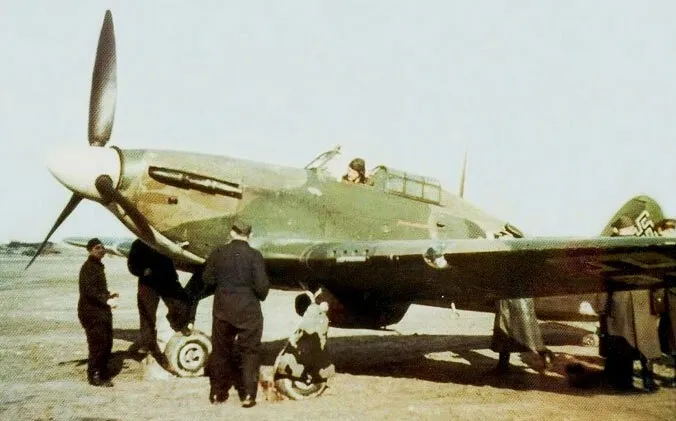




(Luftwaffe Photos)
Hawker Hurricane captured British fighters in Luftwaffe markings.
Hawker Hurricane Mk I Trop* (Serial No. V7670), a former 260 Squadron Hurricane in the Desert Air Force. It had been captured by the Wermacht in April 1941, but was then taken back by the Allies in January of the following year at a place called Gambut in Libya, albeit in poorer condition. * The “Trop” was for “Tropicalized”—meaning fitted with modifications for the desert sand and heat.

(Luftwaffe Photo)
Ilyushin Il-2 Shturmovik, captured Russian fighter-bomber.

(Luftwaffe Photo)
Ilyushin Il-4 Shturmovik, captured Russian bomber.

(Luftwaffe Photo)
Martin B-26B marauder (Serial No. 41-17790), being examined by Germans after its wheels up landed on a Dutch beach. The propellers were badly damaged in the crash landing. The bomber was painted overall Dark Olive Drab over Neutral Gray underside. The squadron's unit codes had not yet been applied.
The B-26 was ferried to Rechlin and trials with the Marauder began in June 1943. A month later, one of the aircraft’s generators failed and a German built one was installed as a replacement. A number of Luftwaffe test pilots were involved in the test program and they reported the same handling difficulties that the Allied pilots faced on their first introduction to the B-26. The Luftwaffe pilots discovered that the short wing span of the Marauder resulted in high landing speeds. The grass runway at Rechlin was too short for the Marauder and after several test flights, the remainder of the test program was moved to Lärz airfield which had a longer, hard surface runway. On 2 November 1943, the Marauder took part in an exhibition of latest Luftwaffe innovations and captured aircraft at Rechlin. Shortly after this exhibit, all references to the Marauder in the Rechlin’s records had stopped. It is believed that the Luftwaffe B-26 was either destroyed in a test flight or during one of the numerous Allied bombing raids on Rechlin. B-26B-1 (Serial No. 41-17790), was the only Marauder that was flown by the Luftwaffe.

(Luftwaffe Photo)
Martin B-26 Marauder (Serial No. 41-17790), captured USAAF light bomber.
The Marauder that never marauded. A Martin B-26B Marauder (41-17790) of the 437th Bomb Squadron of the 319th Bomb Group, USAAF in Luftwaffe markings. This Marauder was evaluated by the Luftwaffe in 1943 and then displayed at an air show in Germany after its bizarre capture on 2 October 1942. The aircraft never saw combat, having been lured to a Dutch island following spurious German radio signals as it was trying to land somewhere safely (following an engine fire) on its remaining engine during its delivery flight from Iceland to Scotland. Flown by 2nd Lieutenant Clarence Wall, the crippled bomber force-landed on a beach in Noord Beveland, Netherlands. (Vintage Wings of Canada)
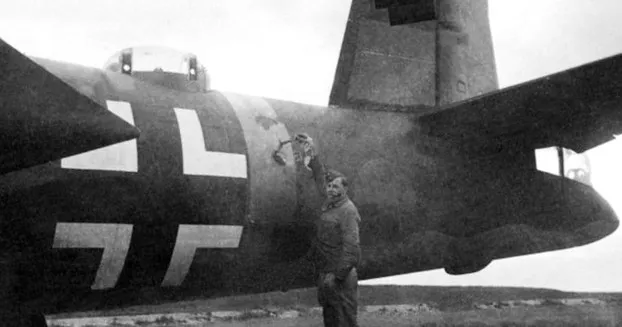
(RAF Photo)
It is surprising that any of the aircraft captured by both Germany and Japan survived the war. Here, an RAF ground crew inspects the former USAAF B-26B Marauder (Serial No. 41-17790) that carried the Nazi markings for nearly two and a half years. The bright yellow fuselage band and tail flashes can still be seen (though barely visible on orthographic film), but the Swastika has been blanked out by a censor in this photo. We can also see the paint circle where the old USAAF star roundel was painted over—just to the right of the airman.

(Luftwaffe Photo)
Mikoyan-Guryevich MiG-3, captured Russian fighter.
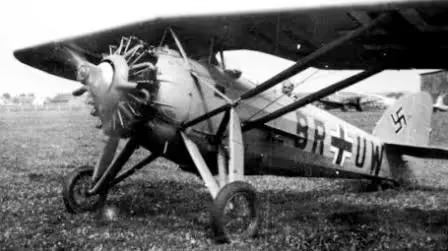
(Luftwaffe Photo)
Morane-Saulnier MS.230 trainer, coded BR+UW, captured in France, summer 1941.




(Luftwaffe Photos)
Morane-Saulnier MS-406 fighter captured in France.



(Luftwaffe Photos)
North American NAA 57 & NAA 64 captured French trainers built in the USA.

(Luftwaffe Photo)
Payen Pa.22 Flechair, +XE, captured in France.

(Luftwaffe Photo)
Petlyakov Pe-2, B+A. captured Russian Bomber.

(Luftwaffe Photo)
Potez 63, +70, captured French light bomber.

(Luftwaffe Photo)
Potez 63, +QL, captured French light bomber.

(Luftwaffe Photo)
Potez-CAMS 161, VE+WW, captured French seaplane.

(Luftwaffe Photo)
Savoia-Marchetti SM.79 Italian transport aircraft in Luftwaffe markings.
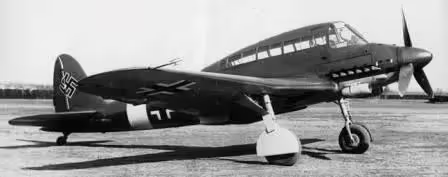



(Luftwaffe Photos)
Savoia-Marchetti SM.93 Italian dive-bomber in Luftwaffe markings.



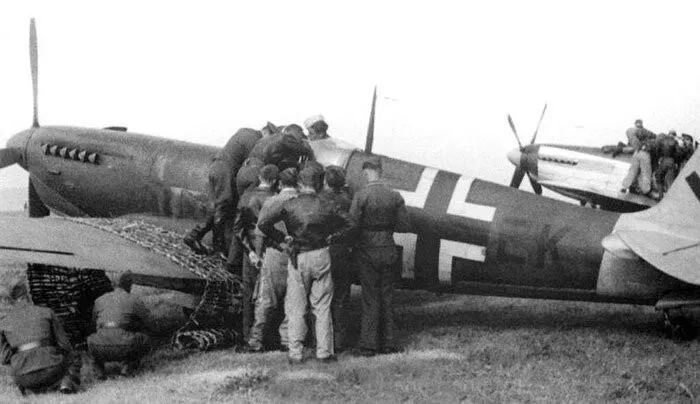
(Luftwaffe Photos)
Supermarine Spitfire, coded CJ-ZY, captured British fighter re-engined with a German Daimler engine.
Given the size of the Balkenkreuz on her sides, the yellow tail and overall dark paint, this is likely the same Spitfire as the previous shot and therefore T9+CK. The Zirkus Rosarius aircraft, including a P-51 Mustang in the background, have landed at a Luftwaffe base to demonstrate their flying abilities and to familiarize other German pilots with their features. This particular Spitfire was a 412 Squadron, RCAF Spitfire. This is the same squadron which John Gillespie Magee, the poet of High Flight, served with until his untimely death.

(Artist's Impression, Fleet Air Archive Photo)
Vought F4U Corsair captured US-built British fighter in Royal Navy service.
Royal Navy F4U-1 Corsair JT404 of No. 1841 Naval Squadron was taking part in an anti-submarine patrol from HMS Formidable enroute to Scapa Flow after Operation Mascot (an against the German Battleship Tirpitz), in company with a Fairey Barracuda flown by Wing Leader Lt Cdr RS Baker-Falkner. The Corsair had to make an emergency landing in a field at Sorvag, Hamarøy north of Bodø, Norway on 18 July 1944. The pilot, Lt Mattholie, taken POW and the aircraft was captured intact with no damage. Luftwaffe interrogators failed to get the pilot to explain how to fold the wings so as to transport the aircraft to Narvik. The Corsair was ferried by boat to Narvik for further investigation. Later the Corsair was taken to Germany and listed as one of the captured enemy aircraft (Beuteflugzeug) based at Erprobungsstelle Rechlin, the central German military aviation test facility and the equivalent of the Royal Aircraft Establishment, for 1944 under repair. This was probably the only Corsair captured by the Germans.
In 1945, a F4U Corsair was captured near the Kasumigaura flight school in Japan by U.S. forces. The Japanese had repaired it, covering damaged parts on the wing with fabric and using spare parts from crashed F4Us. It seems Japan captured two force landed Corsairs fairly late in the war and may have even tested one in flight.

(Luftwaffe Photo)
Vickers Wellington Mk. IC (Serial No. L784), coded 2 KX-T, No. 311 (Czechoslovak) Squadron RAF.
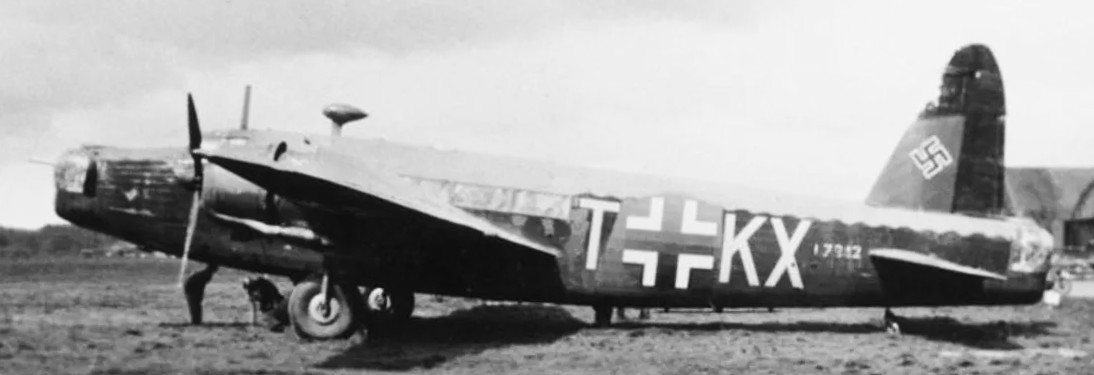
(Luftwaffe Photo)
Captured Vickers Wellington Mk. IC, RAF (Serial No. L7842), coded T+KX.

(Luftwaffe Photo)
Captured Vickers Wellington Mk. IC, RAF (Serial No. L7842), coded T+KX.
Vickers Wellington Mk. IC, RAF (Serial No. L7842), coded T+KX, No. 311 Squadron RAF, was captured by the Luftwaffe. No. 311 Squadron was first formed at RAF Honington, Suffolk on 29 July 1940, equipped with Wellington Mk. I bombers and crewed mostly by Czechoslovakian aircrew who had escaped from Europe. This was before the aircraft received its traditional yellow underside paint used by the Luftwaffe’s Rechlin test facility. L7842 was delivered in mid-1940. It was lost on 6 February 1941 while in service with No. 311 (Czech) Squadron, RAF, while on a mission to Boulogne (France). It was forced to land and captured intact. Luftwaffe markings were added including painting her underside yellow as both the Axis and the Allies did with experimental aircraft. She still carries her No. 311 Squadron code letters (KX-T) and her RAF (Serial No. L7842). The crew was comprised of P/O F. Cigos, Sgt P. Uraba, P/O E. Busina, F/L Ernst Valenta, Sgt. G. Kopal and P/O K. Krizek. All were made Prisoners of War, with Valenta eventually being murdered by the Gestapo following an escape attempt at Sagen POW Camp. (Vintage Wings of Canada)

(Czechoslovak Air Force Photo)
Zlín Z-XII & 212 captured Czechoslovakian trainer.
Kampfgeschwader 200 (KG 200)
Kampfgeschwader 200 (KG 200) was a Luftwaffe special operations unit which carried out difficult bombing and transport operations, long distance reconnaissance flights, tested new aircraft designs and operated captured aircraft. The purpose of KG 200 was a tightly guarded secret and many of its ground personnel were unaware about the nature of the unit’s actual mission or its operations The Germans had a shortage of suitable long range aircraft and captured Allied aircraft were able to operate at night over enemy territory without arising too much suspicion. Captured US B-17s or B-24s were used on some long range reconnaissance missions. Most of the clandestine missions used captured B-17s for re-supply roles (dropping supplies to German forces) and transporting agents or important personnel behind enemy lines. The B-17 was popular with KG 200 pilots who praised its handling characteristics and rugged construction which allowed it to land and take off from grass fields. The nose wheel of the B-24 was unsuitable for operations from grass fields so only a small number of Liberators were used by KG 200.
KG 200 had the following allied fighter aircraft in its inventory:
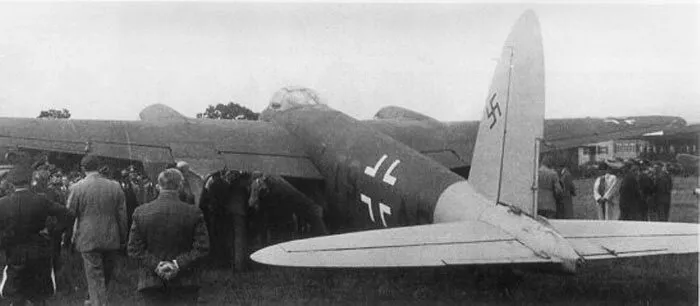
(Luftwaffe Photo)
Captured de Havilland DH.98 Mosquito B Mk. IV, coded T9-XB. This was the only Mosquito captured by the Germans and was listed on the order of battle of KG 200 on 10 November and 31 December 1944. Here, the captured de Havilland Mosquito (T9+XB) fighter/bomber is displayed for the benefit of Nazi party officials and Luftwaffe brass, wearing the bright yellow empennage and undersides of a Zirkus Rosarius aircraft. Here, a captured de Havilland Mosquito (T9+XB) fighter/bomber is displayed for the benefit of Nazi party officials and Luftwaffe brass, wearing the bright yellow empennage and undersides of a Zirkus Rosarius aircraft. (Vintage Wings of Canada)

(Luftwaffe Photo)
Captured Hawker Typhoon Mk. Ia, RAF (Serial No. EJ956), ex"SA-I" No. 486 (NZ) Squadron, coded T9+GK

(Luftwaffe Photo)
Captured Hawker Typhoon, RAF (Serial No. JP548(, Ex No. 174 Squadron, coded T9+GK.
Captured Hawker Typhoon, RAF (Serial No. possibly 0549. Code unknown.

(USAAF Photo)
Lioré-et-Olivier LeO 451T, ex-OK+ZD, captured by the Luftwaffe in France, later captured from the Luftwaffe and photographed in Sicily in 1943 while serving with the USAAF's 57th Fighter Group.

(Luftwaffe Photo)
Latercoere 298, N+GX, captured French floatplane.




(Luftwaffe Photos)
Lavochkin La-5FN, T9+PK, captured Soviet fighter, (Zvezda).
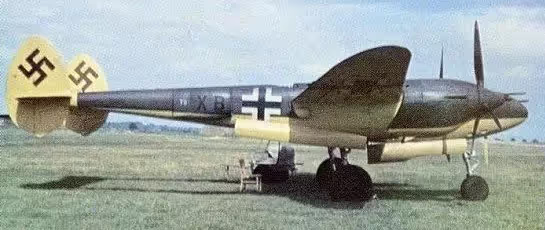
(Luftwaffe Photo)
Lockheed P-38G Lightning (Serial No. 43-2278), coded T9+XB, captured US fighter, 15th Air Force. This aircraft accidentally landed at Capoterra, Italy 12 June 1943.
This Lightning with Luftwaffe Swastikas and crosses wears the typical yellow underbelly and appendages of aircraft under evaluation at the Luftwaffe’s Rechlin Technical Development Centre. This was done so that anti-aircraft crews in the Rechlin area would not shoot at the very-Allied Lightning silhouette. This P-38 T9+XB (USAAF serial 43-2278) was operated by the Zirkus Rosarius and was later used in an air show put on at Rechlin during late 1943. It was captured when the former 15 Air Force Lightning landed by mistake at Capoterra Italy on 12 June 1943. (Vintage Wings of Canada)


(Luftwaffe Photos)
Lockheed P-38 (F-5E) Lightning, (Serial No. 44-23725), Luftwaffe coded T9+MK, captured US fighter, ex 354th Air Service Sqn. Delivered intact by USAAF deserter Martin James Monti, 13 October 1944. While serving with the 354th Air Services Squadron, this particular aircraft was stolen on 13 Oct 1944 by USSAF pilot Martin James Monti (Italian-Swiss father and German mother) when he defected to the Axis side. Monti hitched a flight aboard a C-46 from his base in Pakistan, to Cairo, and then to Italy via Tripoli. He stole the plane from the 354th Air Service Squadron at Pomigliano Airfield, near Naples, Italy, and landed this Lightning near Milan. The Italians had captured the aircraft and handed it over to the Germans. The Lightning was overall bare metal but the Luftwaffe painted the entire underside bright yellow from mid-fuselage down with T9+MK Luftwaffe serials. The aircraft was recaptured by US troops at Schwangau, Germany in May 1945.

(Luftwaffe Photo)
Mechanics and pilots inspect T9+CK, a North American P-51B Mustang that was restored to flying status by the Germans and evaluated at the test facility at Rechlin. Some forum discussions about this particular aircraft (P-51B 42-103458) indicate that it was flown by Lt. Thomas Todd and had force-landed, due to poor weather in a field in Austria, near the Hungarian border. When it was first captured, this Mustang wore overall USAAF dark green camouflage which was the USAAF standard at the time. Only the undersides and empennage were painted bright yellow by the Germans—the standard colour used on Luftwaffe test aircraft. In the personal test flying memoirs of legendary Rechlin test pilot Werner Lerche, his aircraft had landed intact. Here, Luftwaffe ground and air crews check the aircraft out, possibly at a fighter base where the pilots were being taught some of the flying characteristics of the legendary aircraft. (Vintage Wings of Canada)

(Luftwaffe Photos)
North American P-51C Mustang, captured, coded T9+CK. Mustang T9+CK was tested at Rechlin in its original Olive Drab camouflage scheme. This P-51 was later based at Hannover-Wunstorf during the summer of 1944.
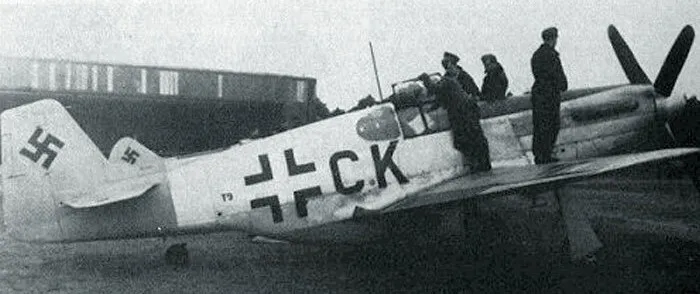
(Luftwaffe Photo)
Mechanics and pilots inspect T9+CK, a North American P-51B Mustang that was restored to flying status by the Germans and evaluated at the test facility at Rechlin. Some forum discussions about this particular aircraft (P-51B 42-103458) indicate that it was flown by Lt. Thomas Todd and had force-landed, due to poor weather in a field in Austria, near the Hungarian border. When it was first captured, this Mustang wore overall USAAF dark green camouflage which was the USAAF standard at the time. Only the undersides and empennage were painted bright yellow by the Germans—the standard colour used on Luftwaffe test aircraft. In the personal test flying memoirs of legendary Rechlin test pilot Werner Lerche, his aircraft had landed intact. Here, Luftwaffe ground and air crews check the aircraft out, possibly at a fighter base where the pilots were being taught some of the flying characteristics of the legendary aircraft. (Vintage Wings of Canada)

(Luftwaffe Photo)
North American P-51B Mustang, (Serial No. 43-24825), "Jerry", ex 334th Fighter Squadron. Captured 6 June 1944, coded T9+HK. Mustang T9+HK was used to train Hungarian fighter pilots at Neuruppin, Germany, on how to use their FW 190s effectively against the P-51. The propeller spinner was painted yellow and there was a red band on the nose of the engine cowling. The fuselage was natural metal with the whole tail and the undersides painted yellow.
P-51B Mustang (T9+HK) gets the same attention as does the P-47 in the background. This P-51B-15-NA (s/n 43-24825) was originally nicknamed “Jerry” and assigned to Lt. Thomas E. Fraser of the 4th FG, 334th FS. It was lost in Cambrai, France, on 6 June 1944 and was tested by the Germans at Rechlin, before being transferred to the famous Zirkus Rosarius for training. It was lost on 10 December 1944. Often, pilots from the Rechlin test establishment would fly the fighters to other German bases and let the pilots there get a really close look at the enemy aircraft. Walter Wolfrum was one of the fortunate pilots who was afforded the opportunity to test fly aircraft like the Mustang: “During the war I had the opportunity to fly captured P-47s and P-51s. I didn’t like the Thunderbolt. It was too big. The cockpit was immense and unfamiliar. After so many hours in the snug confines of the 109, everything felt out of reach and too far away from the pilot. Although the P-51 was a fine airplane to fly, because of its reactions and capabilities, it too was disconcerting. With all those levers, controls and switches in the cockpit. I’m surprised [their] pilots could find the time to fight. We had nothing like this in the 109. Everything was simple and very close to the pilot. You fitted into the cockpit like a hand in a glove. Our instrumentation was complete, but simple: throttle, mixture control and propeller pitch. How [the] pilots were able to work on all their gadgets and still function amazes me.” (Vintage Wings of Canada)
North American P-51D Mustang, coded T9+PK, captured US fighter.

(USAAF Photo)
Piper J-3 Cub, coded GP+, captured light reconnaisance aircraft in Luftwaffe markings, shortly after being re-captured by the USAAF.


(Luftwaffe Photos)
Supermarine Spitfire LF Mk. IX, RAF (Serial No. MK698), ex RCAF No. 412 Sqn, captured, coded T9+EK.
Supermarine Spitfire PR Mk. XI, RAF (Serial No. MB945), ex 14th Photo Squadron, 7th PRG, USAAF, captured, coded T9+BB.
Supermarine Spitfire Mk. IX, captured, coded T9+KK.

(Luftwaffe Photo)
Captured Soviet Yakovlev Yak-15 fighter in Luftwaffe markings.
Zirkus Rosarius (also known as the Wanderzirkus Rosarius) was an Erprobungskommando-style special test unit of the Luftwaffe, specifically of the Luftwaffe High Command, tasked with testing captured British and American aircraft, all of which were repainted in German markings.
The purpose of testing allied aircraft was to discover any strengths or vulnerabilities in their design or performance. This information was highly useful in enabling German service personnel to develop tactics designed to counter strengths and exploit any vulnerabilities.
The unit was formed by Theodor Rosarius in 1943 and was part of the 2./Versuchsverband Oberbefehlshaber der Luftwaffe. The Zirkus also toured operational airfields showing Luftwaffe pilots the captured aircraft and training them in techniques to counter these aircraft. The Zirkus Rosarius seemed to have merited the use of its own Geschwaderkennung (Geschwader code) of "T9", with a few of the unit's aircraft coming from KG 200, which already used the "A3" identification code of that wing.
Zirkus Rosarius - list of known captured aircraft:
Bell P-39 Airacobra, coded GE+DV, captured US fighter.

(IWM Photo, FRE 14506)
B-17G of I./KG 200 under camouflage netting on Wackersleben air field in Germany during 1945. The nose cheek guns and the ball gun turret were removed. A Luftwaffe crew prepares for a mission over Eastern Europe.
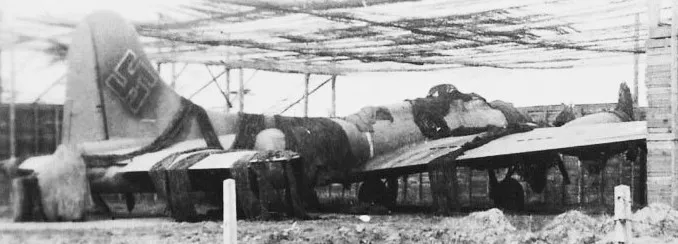
(Luftwaffe Photo)
B-17F of I./KG 200 hidden under camouflage netting at Wackersleben, Germany, in April 1945.




(Luftwaffe Photos)
Boeing B-17F-27-BO Flying Fortress (Serial No. 41-24585), USAAF code PU-B, 303rd Bomb Group (Heavy), 360th Bomb Squadron. This B-17 was lost after carrying out a forced landing in France on 12 Dec 1942. It was coded A3+AE, "Wulf Hound", and flew with KG 200.
Boeing B-17F Flying Fortress (Serial No. 42-30713), code unknown, captured US bomber, "Phyllis Marie" ex 568th Bomb Sq/390th Bomb Gp. Captured 8 March 1944.

(Luftwaffe Photo)
Boeing B-17F Flying Fortress (Serial No. 42-30048), coded A3+CE, captured US bomber, "Flak Dancer" ex. 554th Bomb Sq/384th Bomb Gp. Captured 26 June 1943.
Boeing B-17F Flying Fortress (Serial No. 42-5714), coded DR+PB, captured US bomber, "Old Faithful" ex 332nd Bomb Squadron. Captured 14 October 1943.
Boeing B-17G Flying Fortress (Serial No. 42-39974), code unknown, captured US bomber, "Punchboard" ex 731st Bomb Sq/452nd Bomb Gp. Captured 9 April 1944.

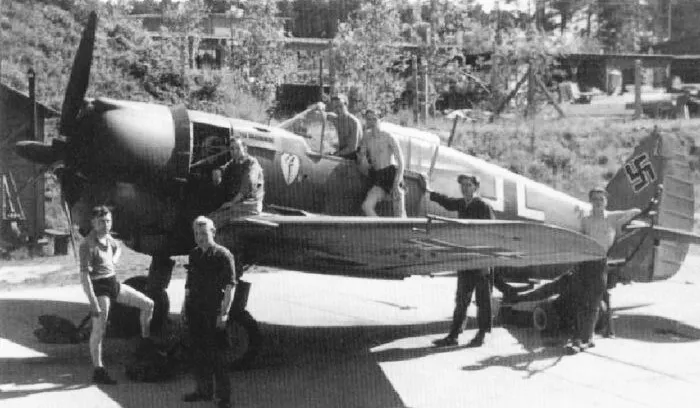
(Luftwaffe Photos)
Curtiss H-75 Hawk, captured from the Armée de l’Air in 1940.
A year and a half before the Americans were in the war, American-designed and -built aircraft like the previous French Norths (Yales) were not only in the war, but already captured and remarked as Luftwaffe. One of these types was the Curtiss Hawk Model 75 (P-36). The Germans captured several dozen of Armée de l’Air Curtiss H-75 Hawks during the French campaign in the summer of 1940. Many of those were subsequently donated (or sold) to Finland, later joined by Norwegian examples up to a total of 44. Others were operated by the Luftwaffe. A dozen of captured Curtiss Hawks were assigned to 7/JG 77 (The Aces of Hearts) during August–October 1940 as interim equipment while awaiting delivery of their Messerschmitt Bf 109s. After this, some were utilized in the fighter-trainer role with Jagdfliegerschule 4 near Nuremberg.
Curtiss Kittyhawk Mk. III, coded 10+KH, captured US fighter.

(Luftwaffe Photo)
Consolidated B-24D Liberator (Serial No. 41-23659), coded I-RAIN, captured US bomber, "Blond Bomber II" ex 343rd BS, 98th BG, USAAF 20 February 1943.
Consolidated B-24G Liberator (Serial No. 42-78106), coded NF+FL, captured US bomber, "Sky Pirate" ex 758th Bombardment Squadron USAF. Captured 9 June 1944.
Consolidated B-24G Liberator (Serial No. 42-78247), coded CL+XZ, captured US bomber, ex 765th BS, 461st BG, USAAF. Captured 4 October 1944.

(Luftwaffe Photo)
Consolidated B-24H Liberator (Serial No. 41-28641), coded A3+KB, captured US bomber, ex-735th BS, 453rd BG, USAAF. Captured 4 February 1944.

(Luftwaffe Photo)
Consolidated B-24H Liberator (Serial No. 42-52106), code unknown, captured US bomber, "Sunshine" ex-719th BS, 449th BG, 47th BW, 15th AF, USAAF. Captured 29 February 1944.
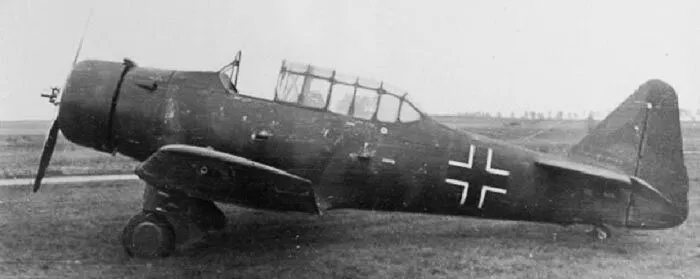
(Luftwaffe Photo)
North American NA-64 Harvard, DR+XD, ex-Armée de l'Air No. 44.
One of the first Allied aircraft to be captured and put to work in Luftwaffe colours during the Second World War were the North American NA-57 and NA-64 trainers of France. The Armée de l’Air, the French Air Force, and the French Navy already had 230 NA-57s and had ordered 230 of the NA-64 Harvard predecessors, and 111 of the initial order (of NA-64s) were already in France when the Germans invaded. They gratefully took the excellent trainers (230 NA-57s and 111 NA-64s), while the other 119 still on order were delivered to Canada and used extensively in training RCAF and commonwealth pilots. The RCAF named them Yales. This camouflaged example of an NA-64 carries only the Balkenkreuz on its fuselage and did not have to endure the indignity of a Hakenkreuz (Swastika) on its tail. (Vintage Wings of Canada)
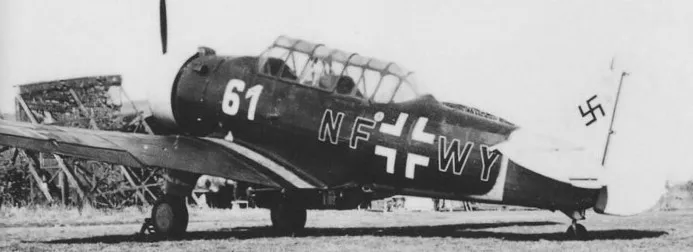
(alternathistory.org.ua/)
An NA-57 in Luftwaffe markings with yellow cowling and empennage, photographed at Guyancourt, France in early 1944.
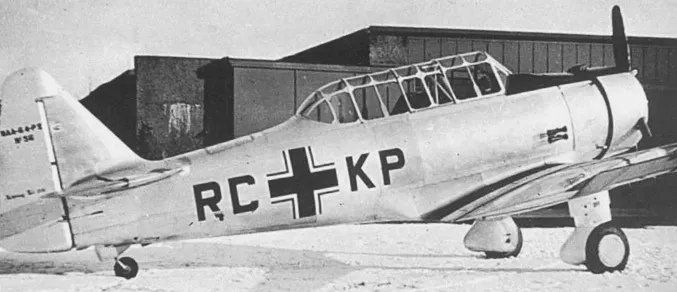
(Luftwaffe Photo)
NA-64 (called North by the French and Yale by the RCAF) warms in the winter sun in Europe somewhere during the Second World War.
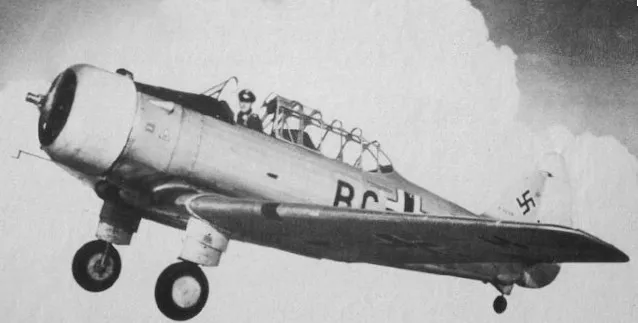
(Luftwaffe Photo)
North American NA-57 Yale.
A Luftwaffe officer with a captured Armée de l’Air North American NA-57. The NA-57 can be identified by its ribbing and fabric covered fuselage. (Vintage Wings of Canada)
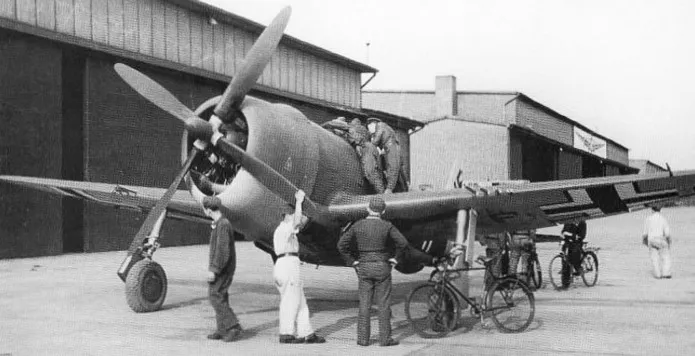

(Luftwaffe Photos)
Republic P-47D-2-RA Thunderbolt (Serial No. 42-22490), coded T9+FK, captured US fighter, ex-358th Fighter Sq/355th FG. Captured 7 November 1943.

(USAAF Photo)
Republic P-47D-11-RE Thunderbolt (Serial No. 42-75971), coded T9+LK, captured US fighter. This aircraft was flown by KG 200 and Zirkus Rosarius until it was re-captured by US forces at Göttingen, Germany in May 1945.


(USAAF Photos)
Republic P-47D Thunderbolt, Luftwaffe, possibly coded T9+PK, captured US fighter shortly after it was re-captured in May 1945.

(Luftwaffe Photo)
Republic P-47D-16-RE (Serial No. 42-75971), coded 8+6, later T9+LK, captured US fighter, ex-301st FS, 332nd FG. Captured 29 May 1944.
Another day and another Luftwaffe base. A Zirkus Rosarius P-47 Thunderbolt (likely T9+FK) draws another group of inquisitive Luftwaffe mechanics and pilots. In his memoir Luftwaffe Test Pilot–Flying captured Allied Aircraft of World War 2, Hans Werner Lerche wrote:
“The P-47 cockpit could baffle even an experienced pilot. I gradually managed to ascertain the function of most of the levers and instruments, but there were also some obscure controls, the meaning of which was not immediately clear to me. For example, the flaps were hydraulically compensation of the flap angle on both sides of the wing, but how this should function was at first a mystery to me. So I decided to try the flaps at a safe altitude and to operate them step by step. Lowered for take-off, they seemed able to take some dynamic pressure.
On the other hand, I was obliged to the Americans for having meanwhile indicated on the instruments with the red and green sections regarding which values were acceptable for the engine and which were not. This was probably due to the fact that the P-47 was also flown in combat by non-English speaking pilots who could not easily understand the inscriptions. The levers for regulating the fuel mixture and the hydraulic constant-speed propeller was moved into full revs when the throttle was fully opened. A warning lamp was provided to indicate over speeding of the exhaust-driven turbine which activated the supercharger of the 2000 hp Double-Wasp radial engine at higher altitudes, but I did not intend to test this during my ferry flight. The sliding cockpit hood in the Thunderbolt was particularly pleasant and could be easily opened at low speeds. The roominess of the cockpit was also pleasantly surprising and comfortable, with the exhaust pipe leading to the turbine behind the pilot’s compartment. I was used to cowering in the Bf 109 seat to avoid continually knocking my head against the cockpit hood, compared to which sitting in the Thunderbolt was flying comfort indeed.
And so came my first flight in our capture Thunderbolt in the afternoon of 10 November 1943. With its broad and robust undercarriage taking off and landing were not difficult at all, but nevertheless it was important to lock the tail wheel to keep the big fighter straight. Later on, I once forgot to do this when taking off and was barely able to avoid a ground loop when landing. There were no difficulties in flight. I first lowered, and everything worked out fine. The engine was running beautifully smoothly, something that I was already accustomed too from the other American aircraft I had test-flown. But I could discover nothing of the speed for which the Thunderbolt was renowned, at least not near the ground level.” (Vintage Wings of Canada)
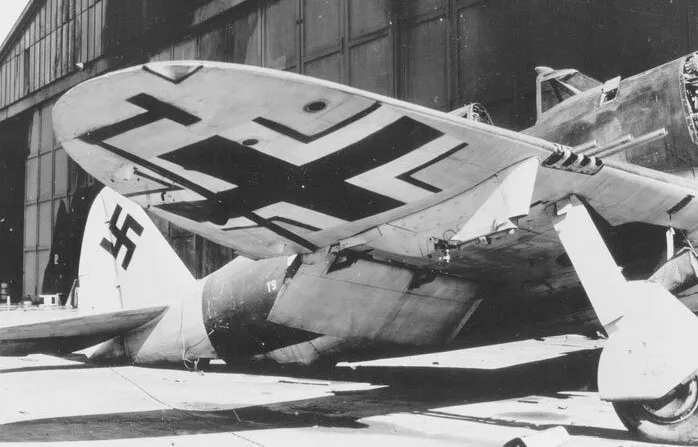
(USAAF Photo)
This P-47 Thunderbolt (T9+LK as this appears to have yellow undersides whereas T9+FK had grey undersides) was captured when its pilot, 2nd Lt Lloyd Hathcock of the 301st Fighter Squadron became disoriented during a mission on 29 May 1944 and landed in Rome, where he and his aircraft were taken. This particular P-47 (sn 42-75971) had at one time been the personal mount of 8-victory ace George Novotny of the 317th. This was the second P-47 captured by the Germans and it quickly made its way to the Wanderzirkus Rosarius at Rechlin. The alphanumerical code “T9” (just visible to the left of the flaps) was the unit code associated with the famed Zirkus Rosarius (also known as the Wanderzirkus Rosarius). The tail and wing undersides would have been painted in bright yellow. Among many Luftwaffe pilots who test flew T9+LK was Hans Werner Lerche. This particular image was taken after Americans captured Göttingen and pulled T9+LK outside.
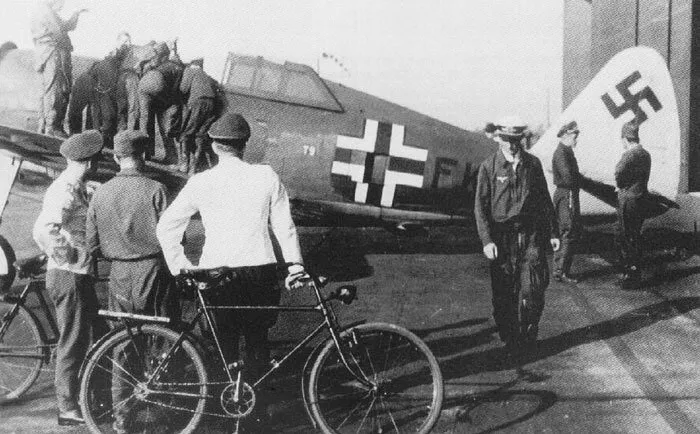
(Luftwaffe Photo)
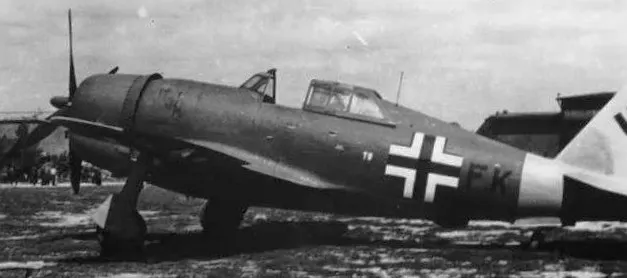
(IWM Photo, FRE 9412)
Republic P-47D2 Thundeerbolt (Serial No. 42-22490), formerly belonging to the 358th FS, 335th FG, had been piloted by Lt. William Roach who mistakenly confused a French airfield with one in Southern England and had landed at Caen. This aircraft was captured in November 1943 and delivered to the Rechlin experimental centre. Later, after receiving a thorough overhaul, it was delivered to the Rosarius Zirkus. The original American paint scheme was replaced by Luftwaffe camouflage and the code T9+FK applied. Evan Gilder of WW2Aircraft.net writes, “On 7 November 1943, 110 B-17s from the 1st and third air division were assigned to bomb aviation industrial targets in Wesel and Duren. They were escorted by 283 Republic P-47 Thunderbolts, working in relays to provide cover for the bombers throughout the mission. Twelve P-47s from the 358th Squadron of the 355th FG would fly their part, taking off with a spare aircraft in case any had difficulty. That spare, “Beetle”, was flown by Lieutenant William E. Roach. Lieutenant John Lanphier developed engine problems and was unable to fly the mission. He returned to base while Roach formed up with Yellow Flight.
The mission was an uneventful mission until they reached the rendezvous point for their relief. The relief had been delayed due to weather. Colonel Cummings chose to stay and protect the bombers, a decision that would prove disastrous. Head winds caused them to burn more fuel than expected. Captain Walter Kossack, the yellow flight leader became disoriented and lost in the clouds. The flight became desperately low on fuel. Captain Kossack ran out of fuel and crash landed on the beach in Caen. Flight Officer Chester Watson ran out of fuel over the North Sea and bailed out to be captured by the Germans and made a POW. Lieutenant Jack Woertz was the only one from Yellow Flight to make it to England, where he crash landed at Hastings, just short of the runway. Lieutenant Roach watched his flight leader go down and looked around for options. He spotted a field nearby. Thinking he was in Southern England, he made a short approach and landed safely. He followed an airfield vehicle to a parking space and had shut down his engine when he realized that he was not in England. Germans approached with their guns drawn. They took him prisoner and he served the rest of the war in Stalag Luft I, with his flight leader, Walter Kossack.
Roach had landed at the Luftwaffe base in Caen. This was the first complete and flyable P-47 that the Luftwaffe had seen. American markings were quickly replaced with German markings. The Luftwaffe wisely chose to move the Thunderbolt inland to keep it away from allied strafing attacks. The P-47 was flown to Rechlin. There it was tested and evaluated thoroughly. The Germans gathered data on the performance, armament and handling of the P-47. During testing, the Germans found the Thunderbolt to be slow and difficult to fly below 15,000 feet. At higher altitudes, they were impressed with its dive speed and roll rate. They were also impressed with the firepower of the 8 .50 caliber machine guns.
As with other fighters tested by the Luftwaffe, after a complete test and evaluation period, Beetle was released to “Zirkus Rosarius”. Zirkus Rosarius was a special Luftwaffe unit under the command of Flugkapitan Ted Rosarius that visited front line fighter units to instruct Luftwaffe pilots on the characteristics, strengths and weaknesses of enemy aircraft. The Germans also captured and flew 2 other P-47 Thunderbolts.
Beetle also became a bit of a movie star. In early 1944, the German propaganda ministry used Beetle for a propaganda film. For the filming, the aircraft paint job was restored to its original American markings. It was returned to Luftwaffe markings after the filming. Nazi propaganda films later also included a captured Spitfire for filming a propaganda film about the Battle of Britain.” (Vintage Wings of Canada)




(Luftwaffe Photos)
Short Stirling Mk.1, RAF (Serial No. N3705), coded 6+8, captured Nritish bomber, ex-No. 7 Squadron RAF.
Short Stirling RAF (Serial No. N3707) with bright yellow test evaluation undersides was one of the stranger aircraft to be captured and test flown. The 7 Squadron RAF Stirling was on a mine-laying mission on 16 August 1942 when the radio operator radioed for a position at 04:58. Within a few hours, the Stirling, piloted by Sgt. S.C. Orrell, made a wheels-down landing in a marshy field near Gorinchem, Netherlands. Luftwaffe personnel from nearby Gilze-Rijen airfield took two weeks to make field repairs to the damaged Stirling and prepare the meadow as a makeshift runway. The Stirling was flown to Gilze-Rijen on 5 September 1942. It was tested at Erprobungsstelle Rechin, Germany, and recoded as Luftwaffe. (Vintage Wings of Canada)
Soviet evaluation of captured Luftwaffe aircraft
According to reports compiled by D.A. Sobolev and D.B. Khazanov a number of captured Luftwaffe aircraft were examined by the Soviet Union during the Second World War. On 23 June 1941, Junkers Ju 88A-5 (Wk Nr. 8260) from III/KG1 Group was hit by flak and landed near the Gulf of Riga coast. This aircraft was quickly examined by Soviet Logistics unit personnel and the data on its defensive armament and the thickness of the armor plates protecting the crew were passed to Soviet aircrews.
One day later, a Junkers Ju 88A-6 (Wk Nr. 2428) from II/KG54 Group made a forced landing near Kiev after it had been hit during an attack on Brovary Airfield. The crew survived was taken prisoner by the Soviets. On 8 July 1941 a third Junkers Ju 88A-5 (Wk Nr. 4341) from KG1 Squadron Hindenburg was hit and with one engine slightly damaged by shrapnel and shells, landed 120 kilometers from Lake Chudskoye, but was not examined.
On 25 July 1941 two of three Ju 88 reconnaissance planes from the 122nd Group were shot down as they flew over the town of Istra. Ju 88 coded F6+AO crashed, but the Ju 88 coded F6+AK made a forced landing, and five days later, it was set up for display to the public on Sverdlov Square in Moscow.
Examination of captured aircraft began in earnest after 29 July, when a special order to establish a permanent commission to receive captured equipment was promulgated. General M. V. Shishkin, Deputy Chief of the Air Forces Scientific Research Institute, chaired the commission.
By the summer and autumn of 1941, front-line Soviet pilots, navigators, and radio operator-gunners were well aware of the speed and lethal fire power of German fighter aircraft armed with longer range cannon and heavy machine guns allowing enemy pilots to set fire to Soviet aircraft, while themselves remaining essentially out of range of ShKAS machine gun fire.
From aircrew debriefings after considerable losses it was clear the Messerschmitts were noticeably faster than the newest Soviet bombers. In theory, based on test flights made in 1940, Bf 109E maximum level speed should not have been much more than that of the Pe-2. The difference did not exceed 15-20 km/h at an altitude of 4000-5000 meters. But, in practice, as regimental commander Colonel A. I. Kabanov pointed out, "The German fighters easily caught up with our Pe-2s and had time to earn' out three-five attacks while pursuing them".
This and other documents indicated that Bf 109 and Bf 110 fighters flew much faster than all types of Soviet bombers, including the modern Yak-4 and Pe-2.
The Soviets noted that in appearance, the Bf 109F (Friedrich) differed from the Bf 109E (Emil) in its unbraced tail unit, rounded rather than square wing tips, flatter canopy top, and engine-mounted cannon instead of two wing guns. The first Messerschmitt Bf 109E-2 (Wk Nr. 12766) was captured in comparatively good condition near the town of Tosno on 20 July 1941 after its pilot failed to make it across the front line in his damaged aircraft. Lieutenant H. Raub of I/JG54 Group made a forced landing and was killed in an exchange of fire with Red Army soldiers. The captured Messerschmitt was featured in an exhibition of trophies in Leningrad. Captured equipment exhibits were also held in Moscow, Kiev and Khar'kov in 1941
Messerschmitt Bf 110C-5 (Wk Nr. 2290), a reconnaissance plane from 3(F)/31 Detachment was captured on the Bryansk Front on 13 September 1941, was examined in detail. This aircraft cockpit was found to have additionally armour, while both MG-FF cannon had been removed, and an automatic long-focal length Pb5O/3O camera was mounted in a "downward-forward" position. The "Soviet" two-engine Messerschmitt never took to the air, although it was immediately sent for examination to the TsAGI New Equipment Bureau. A similar Bf 110C-5 (Wk Nr. 2177), from 4(F)/14 Detachment was shot down by British fighters 21 July 1940, restored, and flown by the RAF at Farnborough. From October 1940 to August 1941, British pilots flew 45 sorties, spending 23 hours and 30 minutes in the air. The aircraft then was maintained in flying condition for a number of years after the end of the Second World War.
During the second half of November 1941 the Soviets captured two more Messerschmitt Bf 109F-2, (Wk Nr. 12811) and (Wk Nr. 12913) and one pilot from 6/JG52 Detachment northwest of Moscow.
By late 1941, specialists from the Air Forces Scientific Research Institute and from other scientific centers had an opportunity to go to various fronts and examine the main German aircraft on the ground. Military engineers noticed the main trend in developing the German aircraft at that time was the increase in engine power. The fighters were fitted with bomb racks; bombers and reconnaissance aircraft had more guns and better armour protection for crews compared to the models bought before the war. Some special technical features were also noticed. Among them there were a fuel jettisoning system on the Ju 88 reconnaissance version, a fixed remotely controlled machine gun fitted in the tail cone and semi-fixed pivot gun mount on the Heinkel He 111, a device for releasing toxic agents from Henschel Hs 126 spotter aircraft, and other "sparks".
The successful Soviet winter counteroffensive led to a significant increase in the amount of captured equipment, including German aircraft. During the period from 5-31 December 34 aircraft were captured in the Moscow area alone. Most of them were damaged or blown up by retreating Germans. The command element of Red Army operational units managed to obtain several Bf 109, Bf 110, Hs 126, Ju 52, He 111 and Bu 31 aircraft. Most of them, as well as aviation equipment and armament, were transported to Moscow for transfer to Tsx\GI, aviation design bureaus, and repair bases. Particular attention was even paid to instrument panels, distribution panels, oxygen bottles, and other less important components. The examining engineers noticed new versions of the Orlikon aircraft cannon. MG 81 turret machine guns, small bombs with rapid-fire fuses, and delayed action bombs, which the enemy began using in winter.
The Soviet Yak-1 fighter seemed to have some capability against the Bf 109, but the LaGG-3, MiG-1 and MiG-3 fighters faced much greater difficulties. Internet: http://www.airpages.ru/eng/ru/lw_trop.shtml.
End of List

Axis Warplane Survivors
A guidebook to the preserved Military Aircraft of the Second World War Tripartite Pact of Germany, Italy, and Japan, joined by Hungary, Romania, Slovakia, Bulgaria, and Yugoslavia; the co-belligerent states of Thailand, Finland, San Marino and Iraq; and the occupied states of Albania, Belarus, Croatia, Vichy France, Greece, Ljubljana, Macedonia, Monaco, Montenegro, Norway, Cambodia, China, India, Laos, Manchukuo, Mengjiang, the Philippines and Vietnam.
The book may be ordered online at:
http://www.lulu.com/shop/harold-a-skaarup/axis-warplane-survivors/paperback/product-20360959.html
http://www.chapters.indigo.ca/books/search/?keywords=axis%20warplane%20survivors&pageSize=12.
Updates to Axis Warplane Survivors would be most welcome.





